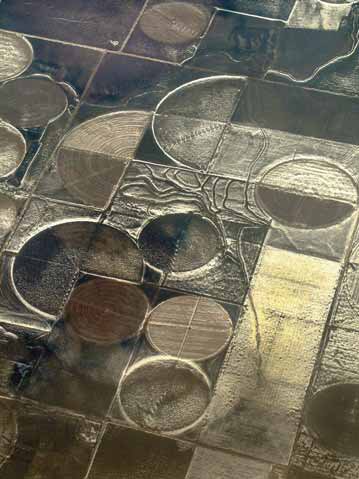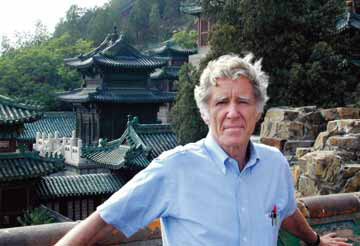SEJournal Online is the digital news magazine of the Society of Environmental Journalists. Learn more about SEJournal Online, including submission, subscription and advertising information.
Science Survey
By RAE TYSON
But Focusing On Economic Fallout May Be Best Course
The impact of climate change, exacerbated by a growing population, is altering the agricultural landscape worldwide, leading food-hungry nations to look elsewhere for cropland. Nearly 140 million acres — an area exceeding the U.S. cropland devoted to growing corn and wheat — have been snapped up across the globe.
 |
|
Two fundamental elements of agriculture that are growing increasingly precious — land and water — coincide at true crop circles (the kind that farmers make) like these in central Missouri. Each one requires a working well at its center to provide water for a radial, concentric system of central pivot irrigation. Photo © Roger Archibald.
|
“Increased pressures on natural resources, water scarcity,export restrictions imposed by major producers when food prices were high, and growing distrust in the functioning of regional and global markets have pushed countries short in land and water to find alternative means of producing food,” said the International Food Policy Research Institute in a recent report.
The land-grab trend, occurring primarily in Africa, Asia and Latin America, has raised concerns among a diverse collection of food rights organizations, environmentalists and the World Bank.
“This is not merely a story about the booming demand for food,” said Lester R. Brown, president of the Earth Policy Institute in Washington, DC. “Everything from falling water tables to eroding soils and the consequences of global warming means that the world's food supply is unlikely to keep up with our collectively growing appetites,” he said in an interview.
In an article he wrote for Foreign Policy magazine, Brown wrote: “The rule of thumb among crop ecologists is that for every 1 degree Celsius rise in temperature above the growing season optimum, farmers can expect a 10 percent decline in grain yields.”
Triggered by population growth and concerns over climate change, the land-grab trend emerged several years ago. Driving it is fear that countries might not be able to supply sufficient grain for domestic consumption by continuing to purchase it in the international marketplace.
Crop yields in the United States have long served as food-supply insurance policy for many countries. But in recent years,the U.S. has steered more and more of its grain to production of ethanol, a mandated supplement for motor vehicle fuel. As a consequence, the United States has increasingly smaller quantities of grain for export.
In response, countries like Saudi Arabia, South Korea and China — along with profit-hungry private corporations — began buying or leasing land in other countries to grow grain. Many of the land acquisitions were in Africa, where cropland can be leased for as little as $1 per acre per year. Similar trends have been noted in Asia and Latin America.
These transactions typically confer water rights, meaning that land purchases and leases potentially affect downstream countries. “Land grabs are, for the most part, water grabs as well,” Brown said.
For example, water extracted from the upper Nile River basin to irrigate crops in Ethiopia or Sudan will now not reach Egypt. “That’s one of the more dramatic examples,” Brown said.
The potential is high for these large land acquisitions to spark conflict, and not just over water. Reporter John Vidal, writing in Britain’s Observer, quoted Nyikaw Ochalla from Ethiopia's Gambella region: “The foreign companies are arriving in large numbers, depriving people of land they have used for centuries. There is no consultation with the indigenous population. The deals are done secretly. The only thing the local people see is people coming with lots of tractors to invade their lands.”
 |
|
Lester Brown in China. © Photo Courtesy Earth Policy Institute.
|
Examples of land acquisitions generating controversy are numerous and widespread. In 2007, for example, as food prices began to rise, China signed an agreement with the Philippines to lease 2.5 million acres of land slated for food crops that would be shipped home. The deal was suspended after word of the agreement was publicized. Similarly, in Madagascar, where a South Korean firm, Daewoo Logistics, had pursued rights to more than 3 million acres of land, a contract was cancelled, a move that eventually toppled the government.
More recently, according to the on-line Fast Company, the Chinese Politburo commanded state-owned enterprises to purchase or lease farmland by the millions of acres to ensure adequate food supplies for the nation’s fast-growing population. In 2010, Heilongjiang Beidahuang Nongken Group — China's largest state-run agricultural conglomerate — agreed to develop almost 500,000 acres of farmland in Argentina, followed by another 494,000 acres this year. A month later, Chongqing Grains announced a $2.5 billion deal to produce soybeans in Brazil.
Ultimately, Latin America is a more likely candidate to become the world’s next bread basket, according to Fast Company. “While China is limited to 140 million hectares of agricultural cultivation, Brazil is using 80 million hectares now, has another 200 million hectares of pasture for cattle, and can insert another 140 million hectares into production without encroaching on ecologically protected areas,” said Charles Tang, president of the Brazil-China Chamber of Commerce.
“Imagine that a single company buys up, in one fell swoop, the entire surface area of Hampshire, or Luxembourg, or half of Tuscany, Maryland or Schleswig Holstein,” said Duncan Pruett of Oxfam International. “Last year, around 45 million hectares of land were sold to private investors, the size of the entire country of Sweden. Many individual land deals were indeed as big as Maryland, but most were done in Africa.”
The environmental impacts of this land-grab phenomenon are ripe for journalistic exploration. Coverage of land acquisitions in leading publications, notably the New York Times and the Guardian, has zeroed in on the economic implications — and not the environmental consequences. So far, the potential environmental impact has not been assessed — or fully understood. “We do not understand very well where things are heading,”said Brown.
“It is a game-changing period we are into here,” Brown said. “With [world] grain stocks low and climate volatility increasing, the risks are also increasing. We are now so close to the edge that a breakdown in the food system could come at any time.”
Rae Tyson is a veteran journalist and co-founder of SEJ. Currently on the staff of Environmental Health News. Tyson lives in an old farmhouse near Gettysburg, Pa.
Bibliography:
- May/June 2011: “The New Geopolitics of Food”; Lester R. Brown, Foreign Policy magazine
- April 2009: “‘Land Grabbing’ by Foreign Investors in Developing Countries: Risks and Opportunities”; International Food Policy Research Institute
- 2011: “World on the Edge: How to Prevent Environmental and Economic Collapse”; Lester R. Brown, Earth Policy Institute
Sources:
- Institute of Public and Environmental Affairs; Beijing - Tel: +86 010 6718 9470, 6713 6387; ipe@ipe.org.cn
- Oxfam International; Matt Grainger, Head of Media - tel: +44 1865 339128; matt.grainger@oxfaminternational.org
Contacts:
- Lester Brown; Earth Policy Institute; (202) 496-9290
- Michele Pietrowski; Senior Communications Specialist, International Food Policy Research Institute (IFPRI); (202) 862-4630 or m.pietrowski@cgiar.org
- The World Bank; Washington, DC; (202) 473-1000
From the quarterly newsletter SEJournal, Fall 2011 issue.











 Advertisement
Advertisement 



